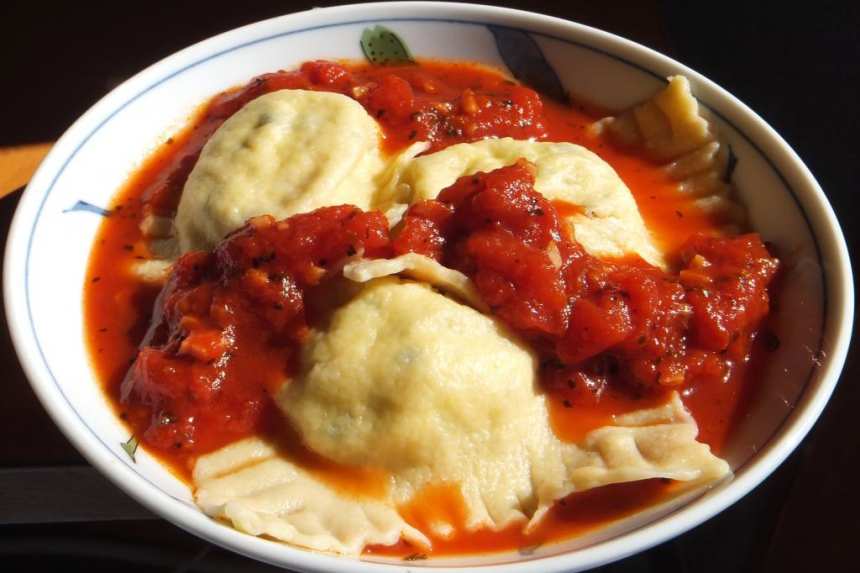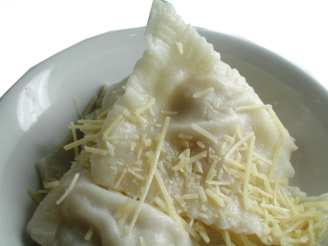Homemade Ravioli

photo by mianbao


- Ready In:
- 1hr
- Ingredients:
- 6
- Serves:
-
12
ingredients
- 1 gallon reconstituted dry milk
- 1⁄2 cup vinegar
- 1 teaspoon salt
- pasta dough
- 2 cups flour (about 350 grams)
- 2 large eggs
directions
- Using a thermometer, heat the milk until it reaches a temperature of 190°F If no thermometer is available, judge the temperature approximately by bringing the milk to a near boil, then removing from heat.
- Stir in the vinegar, then allow the milk to sit until it has reached room temperature.
- The milk will separate into curds and whey (coagulated cheese in water). Scoop the curds into a colander and drain off the whey. Sprinkle with salt. (Save the whey - it can be used as a substitute for buttermilk to make tender biscuits or other baked goods). Cream and butter may optionally be added to the curds for a richer texture. The curds have now become cottage cheese and are ready to be used in the filling.
-
Filling:
- Measure out 4-5 cups of the cottage cheese. Season it with cracked black pepper, chopped fresh or dry parsley (about 1/4 cup) or use the same amount of thawed frozen or chopped fresh spinach to combine with the cheese.
- A 1/4 teaspoon each of basil and oregano, and 1/4 cup grated Romano or Parmesan cheese along with 2 whole eggs (dry whole eggs or egg substitutes can be used in a pinch). Add a dash of nutmeg, if desired.
- Mix well to distribute seasonings. PASTA DOUGH Note: 00 is a fine flour with a lower gluten content than all-purpose flour. If you don't have this on hand, use all purpose flour instead.
- To prepare the mixture by hand, place the flour on a clean counter top or rolling board and make a well in the center.
- Break the eggs into the well and using a fork, beat the eggs, gently drawing in flour from the sides. Continue dragging flour into the center well, stirring the ingredients together until the dough begins to form a homogeneous mass.
- Begin kneading the pasta, first sprinkling the surface with flour.
- IMPORTANT: If the pasta is too dry or crumbly, spray with a little lukewarm water. When the right texture has been reached, form a ball and leave to rest under an inverted bowl for 10-15 minutes.
- Roll dough to 1/8" thickness or less, evenly. This is best done using a pasta machine, but can be accomplished with a rolling pin.
- Make 2 rectangular dough sheets about 12 inches long by 6 inches wide. This is the ideal size for most ravioli tray, but if you don't have one, make them the old-fashioned way! Place scoops of filling on top of the first dough sheet at intervals about 2 inches apart. Top with the second sheet of dough, covering the filling gently, then cut the ravioli out by slicing between the filling "pillows" to yield individual pockets.
- If you're making circular ravioli, you can sandwich the filling between two layers of pasta, then cut circles around the filling mounds using a cup or a special ravioli cutter, available at kitchen supply shops. Or simply cut a single circle, add filling to one side, then fold over and seal, to make half circles.
- Be careful not to drop any filling onto the edges of the ravioli or you won't get a good seal. It's also important to make sure that the edges are well pressed together so that the filling doesn't fall out when the ravioli are boiled. If in doubt, the edges can be pressed together with the tines of a fork.
- Cook the ravioli in a large quantity of rapidly boiling salted water. Drop them gently into the water and watch carefully, as fresh pasta cooks quickly. When the ravioli is cooked, it will rise to the surface. Remove using a slotted spoon or drain in a colander. Serve with a rich, simple, pasta sauce.
Reviews
-
well if you have A LOT of time on your hands and will power (which I normally have little of LOL) this recipe is great. I added a ton of seasoning to the filling mixture and a bit of butternut squash I hd mashed in the freezer waiting to be used. This recipe was a great learning experiance for me, and was quite tiring once it was all said and done.... but boy let me tell you ravaioli, or any meal for that matter, has never tasted this good! In a kinda silly way it felt so good knowing I did this all myself :)
-
This is a wonderful motivating recipe, and I had a lot of fun with it. I did change it around quite a lot, so will not assign stars. A few things I noticed: I used dry skim milk for the filling, and nearly (but not actually, thank goodness) burned it. I didn't have a thermometer, the battery in my last one having died, and was stirring occasionally, which evidently wasn't enough. So watch out when heating the milk. My cottage cheese turned out quite firm. I added about 1/2 cup cream I had on hand, but it still is definitely different from store bought cottage cheese. And, frankly, I'm not so sure of the flavor. I'm thinking of trying making cottage cheese with a quart of whole milk and 2 tablespoons vinegar, to see how it differs. The yield from 1 gallon milk was also only 3 cups. I used half semolina and half bread flour in the pasta. The mixture was extremely dry, and I added another egg, and some flour to make up for it, rather than keep spraying the dough with water. That seemed to be the right decision, especially since I think the eggs I used were a little small. The pasta dough made with semolina is a joy to work with, being completely nonsticky. BTW, my research tells me that 00 flour is very finely milled, but the protein (which makes the gluten) content, is often fairly high. The gluten acts differently than in bread dough, however. This recipe has a lot of information that is useful for a person starting out as a ravioli chef. Thank you very much for sharing it.
RECIPE SUBMITTED BY
I live alone, but love to cook. Sometimes it's hard to cook for one person, but I try.



